Microsoft NSD-1GW Dual Mode AMPS Band CDMA Cellular Transceiver User Manual C TEMP 5180i 1 1
Microsoft Mobile Oy Dual Mode AMPS Band CDMA Cellular Transceiver C TEMP 5180i 1 1
User Guide
Nokia 5180i
User Guide
(Phase 1 SW)
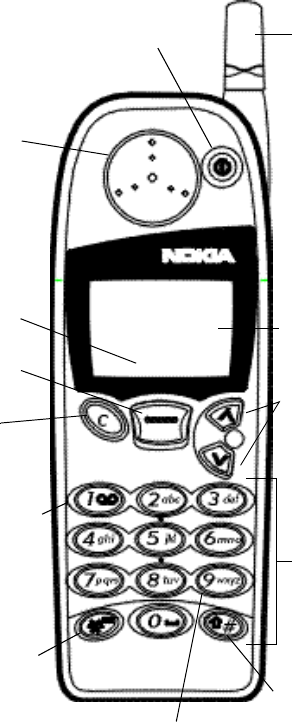
Keys
Menu
Power key
See p. 8.
Navi™ key
See p. 8. Scroll keys
See p. 9.
Emergency 9 key
See p. 31.
Voice mail key
See p. 47.
Number keys
See p. 13.
Retractable
antenna
See p. 17.
Earpiece
See p. 18.
Screen
Current
function of
Navi™ key
C key
See p. 9.
Case key
See p. 13.

Indicators and icons
You are in an active call.
You have one or more new voice messages.
You have one or more new text messages.
Keyguard is on. Your phone will not accept any
keypresses. To turn it off, press Unlock, then .
The alarm clock is set.
Tones are set to Silent. (All tones are turned off.)
Digital service is available.
Your phone is roaming outside its home system.
The phone is ready for you to enter a response.
Characters entered will be upper-case letters. Press
the key to switch letter case.
Characters entered will be lower-case letters. Press
the key to switch letter case.
Characters entered will be numbers. (When entering
letters, switch to numbers by pressing and holding
thekey.)
Contents
1. For your safety 1
FCC/Industry Canada Notice. . . . . . . . . . . . . . . . . . . 2
Using this Guide. . . . . . . . . . . . . . . . . . . . . . . . . . . . . 2
2. Battery installation and charging 3
Attaching the battery . . . . . . . . . . . . . . . . . . . . . . . . 3
Battery charging . . . . . . . . . . . . . . . . . . . . . . . . . . . . 3
Removing the battery . . . . . . . . . . . . . . . . . . . . . . . . 5
Important battery information . . . . . . . . . . . . . . . . . 5
3. About the phone, keys and menu 6
Power key . . . . . . . . . . . . . . . . . . . . . . . . . . . . . . . . . . 6
Nokia Navi™ key. . . . . . . . . . . . . . . . . . . . . . . . . . . . . 6
Ready screen. . . . . . . . . . . . . . . . . . . . . . . . . . . . . . . . 6
Scroll keys. . . . . . . . . . . . . . . . . . . . . . . . . . . . . . . . . . 7
Clear key. . . . . . . . . . . . . . . . . . . . . . . . . . . . . . . . . . . 7
Lights. . . . . . . . . . . . . . . . . . . . . . . . . . . . . . . . . . . . . . 7
External antenna jack . . . . . . . . . . . . . . . . . . . . . . . . 7
Menu. . . . . . . . . . . . . . . . . . . . . . . . . . . . . . . . . . . . . . 8
Entering letters and numbers . . . . . . . . . . . . . . . . . 11
Special characters in names . . . . . . . . . . . . . . . . 12
Special characters in phone numbers. . . . . . . . . 12
Keyguard (locking the keypad) . . . . . . . . . . . . . . . . 13
4. Basic functions 15
Turning the phone on . . . . . . . . . . . . . . . . . . . . . . . 15
Turning the phone off . . . . . . . . . . . . . . . . . . . . . . .15
About the antenna. . . . . . . . . . . . . . . . . . . . . . . . . . 15
Checking signal strength. . . . . . . . . . . . . . . . . . . . . 16
Making a call . . . . . . . . . . . . . . . . . . . . . . . . . . . . . . 16
Volume adjustment (earpiece) . . . . . . . . . . . . . . . . 16
Muting the microphone. . . . . . . . . . . . . . . . . . . . . . 16
Ending a call. . . . . . . . . . . . . . . . . . . . . . . . . . . . . . . 17
Last number redial. . . . . . . . . . . . . . . . . . . . . . . . . . 17
Saving a name and number. . . . . . . . . . . . . . . . . . . 17
Finding a name and number . . . . . . . . . . . . . . . . . .17
Answering a call. . . . . . . . . . . . . . . . . . . . . . . . . . . .17
Silencing an incoming call. . . . . . . . . . . . . . . . . . . .18
5. Phone book 19
Saving names and numbers. . . . . . . . . . . . . . . . . . .19
Finding names and numbers . . . . . . . . . . . . . . . . . .20
Editing names and numbers . . . . . . . . . . . . . . . . . .20
Erasing names and numbers . . . . . . . . . . . . . . . . . .21
Finding your own number . . . . . . . . . . . . . . . . . . . .21
Scrolling view. . . . . . . . . . . . . . . . . . . . . . . . . . . . . .21
Checking available memory. . . . . . . . . . . . . . . . . . .21
6. Settings 22
Automatic redial. . . . . . . . . . . . . . . . . . . . . . . . . . . .22
Clock . . . . . . . . . . . . . . . . . . . . . . . . . . . . . . . . . . . . .22
Language. . . . . . . . . . . . . . . . . . . . . . . . . . . . . . . . . .23
Lights. . . . . . . . . . . . . . . . . . . . . . . . . . . . . . . . . . . . .23
Tones . . . . . . . . . . . . . . . . . . . . . . . . . . . . . . . . . . . . .24
Quick alert settings. . . . . . . . . . . . . . . . . . . . . . . .25
Voice mailbox number . . . . . . . . . . . . . . . . . . . . . . .26
Welcome note. . . . . . . . . . . . . . . . . . . . . . . . . . . . . .27
7. Emergency calls 28
Emergency key 9. . . . . . . . . . . . . . . . . . . . . . . . . . .29
8. Advanced functions 30
Network feature setting. . . . . . . . . . . . . . . . . . . . . .30
Adding feature activation codes to the menu . .30
Adding feature cancellation codes to the menu 30
In-call menu . . . . . . . . . . . . . . . . . . . . . . . . . . . . . . .31
Making/receiving multiple calls . . . . . . . . . . . . . . .31
Calling cards. . . . . . . . . . . . . . . . . . . . . . . . . . . . . . .33
Call forwarding. . . . . . . . . . . . . . . . . . . . . . . . . . . . .34
1-touch dialing. . . . . . . . . . . . . . . . . . . . . . . . . . . . .36
Choosing your phone number (NAMselection). . .37
Send own number . . . . . . . . . . . . . . . . . . . . . . . . . .37
NAM update . . . . . . . . . . . . . . . . . . . . . . . . . . . . . . .38
System. . . . . . . . . . . . . . . . . . . . . . . . . . . . . . . . . . . . 39
Anykey answer . . . . . . . . . . . . . . . . . . . . . . . . . . . . .40
Automatic answer . . . . . . . . . . . . . . . . . . . . . . . . . . 40
Touch tones . . . . . . . . . . . . . . . . . . . . . . . . . . . . . . . 40
Restore factory settings. . . . . . . . . . . . . . . . . . . . . . 41
9. Call log 42
Missed calls . . . . . . . . . . . . . . . . . . . . . . . . . . . . . . . 42
Received calls. . . . . . . . . . . . . . . . . . . . . . . . . . . . . . 43
Dialed calls . . . . . . . . . . . . . . . . . . . . . . . . . . . . . . . . 43
Clearing call lists . . . . . . . . . . . . . . . . . . . . . . . . . . . 43
Call timers. . . . . . . . . . . . . . . . . . . . . . . . . . . . . . . . . 43
10.Voice messages 45
Saving your voice mailbox number. . . . . . . . . . . . . 45
Listening to new voice messages . . . . . . . . . . . . . . 45
Calling your voice mailbox at any time . . . . . . . . . 46
11.Text messages 47
Reading messages . . . . . . . . . . . . . . . . . . . . . . . . . . 47
Storage of incoming messages. . . . . . . . . . . . . . . . 48
12.Extra features 49
Alarm clock. . . . . . . . . . . . . . . . . . . . . . . . . . . . . . . . 49
Games. . . . . . . . . . . . . . . . . . . . . . . . . . . . . . . . . . . . 50
13.Security features 52
Access codes overview. . . . . . . . . . . . . . . . . . . . . . . 52
Lock code. . . . . . . . . . . . . . . . . . . . . . . . . . . . . . . . 52
Security code . . . . . . . . . . . . . . . . . . . . . . . . . . . . 52
Restricting calls . . . . . . . . . . . . . . . . . . . . . . . . . . . . 52
Phone lock . . . . . . . . . . . . . . . . . . . . . . . . . . . . . . . . 56
14.Accessories 57
Nokia Xpress-on™ color covers. . . . . . . . . . . . . . . . 57
Batteries . . . . . . . . . . . . . . . . . . . . . . . . . . . . . . . . . 60
Chargers and other accessories . . . . . . . . . . . . . . . 61
15.Reference information 64
Important safety information . . . . . . . . . . . . . . . . . 64
Emergency calls . . . . . . . . . . . . . . . . . . . . . . . . . . . .66
Radio frequency (RF) signals. . . . . . . . . . . . . . . . . .67
Care and maintenance. . . . . . . . . . . . . . . . . . . . . . .68
. . . . . . . . . . . . . . . . . . . . . . . . . . . . . . . . . . . . . . . . . .68
16.Technical information 69
17.Nokia One-Year Limited Warranty 70
18.Index 74

3
1. For your safety
Read these simple guidelines before using your phone.
Failure to comply with these guidelines may be dangerous
or illegal.
Road Safety Comes First
Don’t use a hand-held phone while driving; park the
vehicle first.
Switch Off In Hospitals
Follow any regulations or rules. Switch phone off near
medical equipment.
Switch Off On Aircraft
Wireless phones can cause interference. Using them on
aircraft is illegal.
Switch Off When Refueling
Don’t use phone at a refueling point. Don’t use near fuel or
chemicals.
Switch Off Near Blasting
Do not use the phone where blasting is in progress.
Observe restrictions, and follow any regulations or rules.
Interference
All wireless phones may get interference which could
affect performance.
Use Sensibly
Use only in the normal position (to ear). Don’t touch the
antenna unnecessarily.
Qualified Service
Only qualified service personnel must install or repair
equipment.
Accessories and Batteries
Use only approved accessories and batteries. Do not
connect incompatible products.
4
FCC/Industry Canada Notice
Your phone may cause TV or radio interference (for example,
when using a telephone in close proximity to receiving
equipment). The FCC or Industry Canada can require you to
stop using your telephone if such interference cannot be
eliminated. If you require assistance, contact your local
service facility.
This device complies with part 15 of the FCC rules.
Operation is subject to the condition that this device does
not cause harmful interference.
Using this Guide
The wireless phone described in this guide is approved for
use in CDMA 800 and AMPS networks.
Network services
A number of features included in this guide are called
network services. They are special services provided by
wireless service providers. Before you can take advantage of
any of these network services, you must subscribe to the
service(s) from your home service provider and obtain
instructions for their use.
Updates
The latest version of this Owner’s Manual may be found on
Nokia’s World Wide Web site at www.nokia.com.
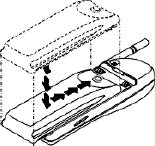
5
2. Battery installation and
charging
Before you can use your new phone, you need to attach and
charge the battery.
Attaching the battery
To attach the battery, place it
on the back of the phone as
shown and slide it toward the
top of the phone until it clicks
into place.
Battery charging
Your phone is powered by a rechargeable NiMH or lithium
ion (Li-Ion) battery. Note that a new NiMH battery’s full
performance is achieved only after two or three complete
charge and discharge cycles (see ‘Charging times’ on page
63).
How to charge your battery
Connect the lead from the charger to the bottom of your
phone or to a charging stand. Then plug the charger into a
standard wall outlet.
When the battery is charging, the battery strength indicator
on the right side of the screen scrolls upwards.
Note:When you charge the battery for the first time, the
battery strength indicator will not scroll the entire time; this
is normal.

6
Problems charging
If your phone displays Not charging, charging is suspended.
Check that the battery is connected to an approved
charging device. If the battery is very hot or cold, wait for a
while; charging will automatically resume after the battery
is restored to its normal operating state. If charging still
fails, contact your dealer.
When is charging complete?
When the battery strength indicator stops
scrolling, your phone is considered fully charged.
However, a slight increase in charge may occur if
you leave your phone connected to the charger.
If you charge the battery while the phone is turned
off, the charge bars on the right side of the display will
eventually disappear once a full charge has occurred.
Note: If you are using a lithium ion battery, continue to
charge it for two hours after the indicator has stopped
scrolling to retain “trickle charge”.
When is a good time to charge?
You can charge anytime, but remember that when your
phone displays Battery low, you only have a couple of
minutes of talk time left.
Can I make calls while charging?
Yes, but your battery may not charge during a call. Charging
should resume once you end the call.
Discharging NiMH batteries
For good operation times, discharge NiMH batteries from
time to time by leaving your phone switched on until it
turns itself off (or by using the battery discharge facility of
any approved accessory available for your phone). Do not
attempt to discharge the battery by any other means.
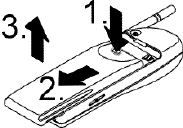
7
Removing the battery
Note:Switch off the phone before removing the battery!
1Press and hold the
button at the top of the
battery.
2Slide the battery
toward the bottom of
the phone.
3Lift the battery off the
phone.
Important battery information
•The battery can be charged and discharged hundreds of times
but it will eventually wear out. When the operating time (talk
time and standby time) is noticeably shorter than normal, it is
time to buy a new battery.
•Use only batteries approved by the phone manufacturer and
recharge your battery only with the chargers approved by the
manufacturer. When a charger is not in use, disconnect it from the
power source. Do not leave the battery connected to a charger for
longer than a week, since overcharging may shorten its life. If left
unused a fully charged battery will discharge itself over time.
•Temperature extremes will affect the ability of your battery to
charge: allow it to cool down or warm up first.
•Use the battery only for its intended purpose.
•Never use any charger or battery which is damaged or worn out.
•Do not short circuit the battery. Accidental short circuiting can
occur when a metallic object (coin, clip, or pen) causes direct
connection of the + and - terminals of the battery (metal strips
on the back of the battery), for example when you carry a spare
battery in your pocket or purse. Short circuiting the terminals
may damage the battery or the connecting object.
•Leaving the battery in hot or cold places, such as in a closed car
in summer or winter conditions, will reduce the capacity and
lifetime of the battery. Always try to keep the battery between
59ºF and 77ºF (15ºC and 25ºC). A phone with a hot or cold
battery may temporarily not work, even when the battery is fully
charged. NiMH batteries’ performance is particularly limited in
temperatures below 14ºF (-10ºC). Li-Ion batteries’ performance
is particularly limited in temperatures below 32ºF (0ºC).
•Do not dispose of batteries in a fire!
•Dispose of used batteries in accordance with any local regulations.
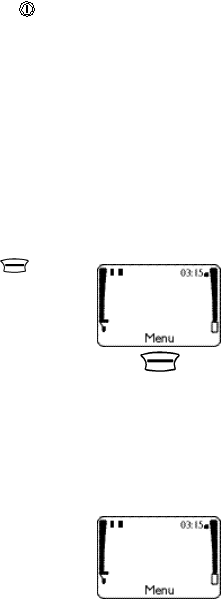
8
3. About the phone, keys and
menu
Power key
You can use the power key to:
•turn the phone on or off (press and hold)
•turn the phone’s lights on for 15 seconds
•select a quick alert setting (see page 27) (if Keyguard is
off and the phone is not connected to a headset or
handsfree car kit.)
For more information on Keyguard, see ‘Keyguard (locking
the keypad)’ on page 15.
Nokia Navi™ key
Your phone’s Navi™ key appears
below the screen. Its current function
is indicated by the word that appears
above it (for example, Menu). Simply
press the Navi™ key to perform the
function.
Throughout this guide, when you see “press Menu,” “press
Listen,” etc., press the Navi™ key when that word appears
above it.
Ready screen
The Ready screen appears when you
first turn on your phone. Menu
appears above the Navi™ key so you
can access your phone’s menu. Several
features can be used only when the
phone is at the Ready screen.

9
To get to the Ready screen, press and hold for a
second. (If there are characters on the screen this clears the
characters, then you must press and hold again.)
Scroll keys
The scroll keys are located to the right of the
Navi™ key. Use the scroll keys to:
•browse menus
•move the cursor (see page 13) to the right or the left
•adjust the earpiece volume while in a call
•access your phone book (press from the Ready
screen)
•access the dialed calls list (press from the Ready
screen)
Clear key
Use the clear key to:
•delete a character to the left of the cursor
•clear all characters from the screen (press and hold)
•return to the previous menu level
•return from the menu to the Ready screen (press and
hold)
•access the in-call menu while in a call (see ‘In-call
menu’ on page 33)
Lights
To turn your phone’s lights on for 30 seconds:
•if Keyguard is off, press any key
•if Keyguard is on, press the key briefly
For information about controlling your phone’s lights when
the phone is in a car kit, see page 25.
External antenna jack
At the back of the phone, below the antenna, there is a
connector for an external antenna. The connector may be

10
protected by a rubber cap. Remove the cap before connecting
an external antenna. After removing the external antenna,
replace the cap.
Note:Keep the cap out of the reach of small children.
Menu
Using your phone’s menu you can easily access the many
powerful features in your phone.
Scroll bar
When you use your phone’s menu, a scroll bar
appears at the far right of the screen. This bar
indicates where you are in the menu; each tab
location on the bar represents a different menu
item.
For example, press Menu once. The scroll bar appears with
the first (top) tab displayed. A different tab appears each
time you press or .
Help text
Many menu items have brief help text. To view the help
text, scroll to the menu item and wait for approximately 10
seconds for the text to appear. Press More or to see the
next page of text, to see the previous page, or to
return to the menu.

11
Menu shortcuts
When you select a menu item, numbers appear on
the screen above the scroll bar. If you become
familiar with these numbers, you can use them as
shortcuts for accessing different menu items.
For example, to access the Phone settings menu,
you can simply press Menu 42. The phone displays the first
item in that menu, Touch tones.
Note: (1) Menu items in your phone vary depending on the
network and accessories used. (2) This is not a complete list;
see entries about individual features for more information.
1Phone book
11 Search
12 Add new
13 Edit
14 Options
141 Scrolling view
142 Memory status
15 1-touch dialing
16 Erase
161 One by one
162 Erase all
17 Own number
2Messages
21 Text messages
211 Inbox
212 Saved
213 Erase all
22 Voice messages
221 Listen to voice
messages
222 Voice mailbox
number
23 Welcome note
3Call log
31 Missed calls
32 Received calls
33 Dialed calls
34 Clear call lists
341 All
342 Missed
343 Received
344 Dialed
35 Call timers
351 Last call
352 All calls
353 Life timer
354 Clear timers
12
4Settings
41 Call settings
411 Emergency key 9
412 Automatic redial
413 Calling card
414 Automatic answerA
415 Anykey answer
42 Phone settings
421 Touch tones
422 Restore factory
settings
423 Language
424 LightsA
43 Security settings
431 Restrict calls
432 Access codes
44 Network services
441 Call forwardingM
442 Call waitingM
443 Send own numberM
444 Network feature
setting
445 NAM selection
446 NAM updateO
5System
51 System search
selection
511 Automatic
512 SemiAuto BO
513 SemiAuto AO
514 Home area
52 Digital/analog selection
521 Digit. & analog
522 Analog
523 Digital
6Games
61 Memory
62 Snake
63 Logic
7Clock
71 Alarm clock
72 Clock settings
721 Display/Hide clock
722 Time settings
723 Time format
8Tones
81 Ringing options
811 Ring
812 Ascending
813 Ring once
814 Beep once
815 Silent
82 Ringing tone
39 tones
83 Ringing volume
831 Level 1
832 Level 2
833 Level 3
834 Level 4
835 Level 5
84 Message alert tone
841 No tone
842 Standard
843 Special
844 Beep once
845 Long & loud
85 Keypad tones
851 Off
852 Level 1
853 Level 2
854 Level 3
86 Warning and game
tones
861 On
862 Off
87 Vibrating alertA
871 On
872 Off
9Keyguard
ADepends on accessory; see entry for this feature
MMust be added to the menu manually; see ‘Network feature setting’
on page 32
ODepends on network or operator
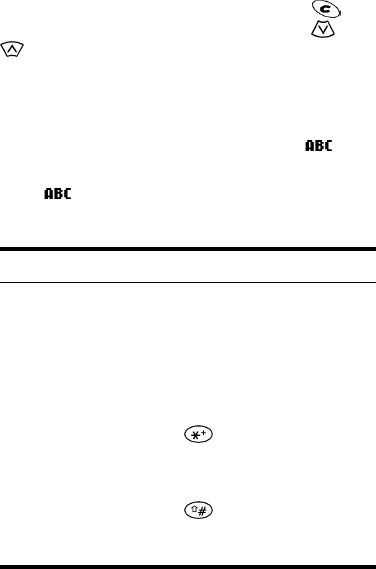
13
Entering letters and numbers
Cursor
The cursor is a blinking vertical line that appears on the
screen when you are entering text or numbers. Characters
you enter appear to the right of the cursor. Press to
delete the character to the left of the cursor. Use and
to move the cursor to the right or left.
ABC mode
When your phone is ready for you to enter text, such as a
name or message, it switches to ABC mode. Theicon
shows that it is in ABC mode.
Whenis displayed, you can enter these characters by
pressing the indicated key repeatedly:
Note:After you enter a character, press down on the scroll
key to move the cursor over quickly.
Key Characters Key Characters
1. , ‘ ? ! - 1 7PQRS7
2ABC2 8TUV8
3DEF3 9WXYZ9
4GHI4 0space, 0
5JKL5 See ‘Special
characters in
names’ on page 14.
6MNO6 Changes letter case,
switches between
letters and numbers
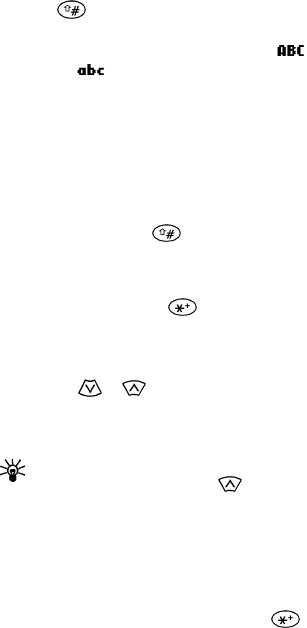
14
Changing letter case
Press the key (the Case key, shown on the phone
diagram on this guide’s inside front cover) to switch
between upper- and lower-case letters. The icon
switches to to indicate that you are using lower case.
Entering numbers
To enter numbers while in ABC mode, you can:
•press and hold the corresponding key until the number
appears, or
•switch between ABC mode and number mode by
pressing and holding .
Special characters in names
In ABC mode you can press (the Special characters key,
shown on the phone diagram on this guide’s inside front
cover) to view the special characters below. You can use
these characters when saving names in your phone book.
Simply press or to highlight the one you want, then
press Use.
. , ? ! : ; - + # * ( ) ‘ “ _ @ & $ £ % / < > ¿ ¡ § = [ ] ¥
Tip: To choose a character that appears near the end
of the list, immediately press to go to the end of
the list.
Special characters in phone numbers
You can use special characters to dial or save phone
numbers of automated services such as bank account
information. When entering numbers, press repeatedly
until you see the character you want.
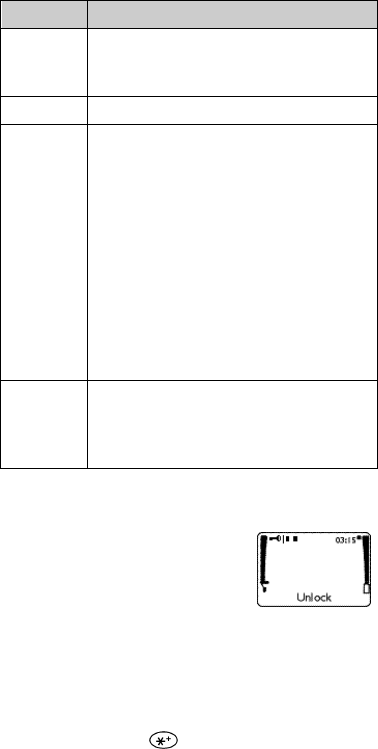
15
Keyguard (locking the keypad)
Using the Keyguard feature you can
“lock” your phone’s keypad so that
accidental keypresses have no effect.
This is handy when your phone is in a
pocket or purse.
Note:Keyguard is not a security feature and will not prevent
unauthorized use of your phone.
To lock the keys
Press Menu 9 or Menu .
Character Use
* This character is used to request services
from the network. Contact your service
provider for details.
+ This character is not currently used.
p This character creates a pause. Digits to the
right of the p are sent as touch tones after a
2.5-second pause.
Use this character to save phone numbers of
automated services that require you to enter
a password or other information after the
call is answered. For example, if your voice
mail number at work is 555-1212 and you
need to enter your extension (1234) and then
a password (5678) in order to listen to your
messages, you could save this phone number
as 5551212p1234p5678.
w This character creates a wait. It works
similarly to the pause character except that
digits to the right of the w are not sent until
you press Send.

16
To unlock the keys
Press Unlock .
Notes about Keyguard
•When Keyguard is on, the only way to answer a call is to
press Answer. Once the call is terminated, keyguard is
reactivated.
•When Keyguard is on, press the power key briefly to turn
your phone’s lights on for fifteen seconds.
•When Keyguard is on, calls may be possible to the
emergency number programmed into your phone
(e.g. 911 or other official emergency number). However,
one-key emergency dialing (‘the 9 key’) does not operate.
Note:When Keyguard is active, the only way to make an
emergency call is to dial the emergency number, then press
Call.
•Keyguard is automatically turned off when the phone is
connected to a car kit. Once the phone is disconnected
from the car kit, keyguard is reactivated.
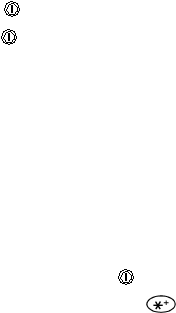
17
4. Basic functions
Turning the phone on
Press and hold for one second.
Note: Pressing briefly turns your phone’s lights on for
fifteen seconds.
If the phone asks for a lock code, see ‘Lock code’ on page 55.
If the phone asks for a security code, see ‘Security code’ on
page 55.
WARNING! Do not switch on the phone when wireless phone
use is prohibited or when it may cause interference or
danger.
Turning the phone off
If Keyguard is off, press and hold for one second.
To deactivate Keyguard, press Unlock .
About the antenna
Your Nokia phone is equipped with an antenna that can be
extended for better performance.
Normal position
Hold the phone as you would any other telephone, with the
antenna pointed up and over your shoulder.
Tips on efficient operation
As with any other radio transmitting device, do not touch
the antenna unnecessarily when the phone is switched on.
Contact with the antenna affects call quality and may cause
the phone to operate at a higher power level than otherwise
needed.
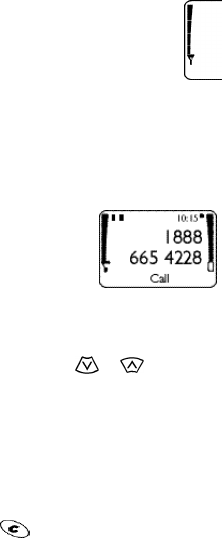
18
Checking signal strength
Your phone operates on radio waves. Radio signal coverage
is maintained by a wireless network, and the quality of calls
on your phone depends on the strength of the wireless radio
signal.
Get a strong signal
When you are at the Ready screen or in a call, the
strength of the radio signal is indicated by the
signal strength indicator on the left side of your
phone’s screen. This indicator scrolls up and down
as the signal strength increases and decreases.
To improve your phone’s reception, try moving your phone
slightly. If you’re inside a building, move toward a window.
Making a call
1Enter the area code and phone
number. (Menu changes to Call.)
2Press Call and wait for the other
party to answer.
Volume adjustment (earpiece)
To adjust the earpiece volume, press or during a
call. If an accessory with its own loudspeaker is connected
to your phone, the scroll keys adjust the volume for that
accessory.
Muting the microphone
When you are in a call, you can mute the phone’s
microphone by pressing , pressing Options, and
selecting Mute. To unmute the microphone, press Options
and select Unmute.
For more information, see ‘In-call menu’ on page 33.

19
Ending a call
Press End.
Last number redial
The last 10 numbers you dialed are stored in the dialed calls
list. Use this list to redial a number you have called recently.
1From the Ready screen, press to access the dialed
calls list.
2Scroll to the desired number.
3Press Call.
Saving a name and number
See ‘Saving names and numbers’ on page 21.
Finding a name and number
1Press to access your phone book.
2Scroll to the number you want. (To skip ahead quickly in
the list, press the number key that corresponds to the
first letter of the name. For example, if you want to call
your friend Katy, press the 5 key twice, quickly; once for
the letter j, and once for the letter k.)
3Press Call.
For other ways to find names and numbers, see ‘Finding
names and numbers’ on page 22.
Answering a call
When someone calls, the phone alerts you (see ‘Tones’ on
page 26) and Call flashes on the screen. To answer the call,
press any key except .

20
Silencing an incoming call
To silence the ringing of the incoming call, press
briefly. You can still answer the call if Call or the name of
the person is still flashing on your screen.
Note:To prevent accidental answering when the phone is in
a pocket or purse, the phone will not answer the call if any
key other than Answer is pressed for longer than one second.
For information on setting your phone to answer incoming
calls automatically, see ‘This feature allows you to answer
an incoming call by pressing any key except . Use Menu 4 1
5 to turn this feature on or off.’ on page 42.
Caller ID
Caller ID is a network service that displays the phone
number of the person calling you, if it is available.
Check with your service provider for details.
If the caller can be identified, the
phone displays the caller's phone
number and calling. If the number
matches a name saved in your phone
book, the name is displayed instead.
However, if the last seven digits of the phone number match
more than one name in the phone book, only the phone
number is displayed.

21
5. Phone book
For convenient and easy dialing, you can save 100 phone
numbers and associated names in your phone.
Saving names and numbers
Saving a name and number is easy!
Just enter the phone number,
press or , then press Save.
Enter a name if you wish, then press
OK.
Saving a number quickly
To save a number quickly, enter the phone number,
press or , then press and hold Save. The number is
saved to your phone book and you can add a name to it later
(see ‘Editing names and numbers’ on page 22).
Saving a name and number while in a call
To save a name and number while in a call, press Options,
scroll to Phone book, scroll to Add new, enter a number and
name if you like, and press OK.
Notes about saving names
•A name may appear only once in memory. If you try to
save a name that already exists in memory, the phone
asks if you want to replace the existing name.
•If you try to save a phone number and your phone book
is full, you are given the option to replace an existing
entry. Scroll to the entry you want to replace and press
OK, or press to cancel.
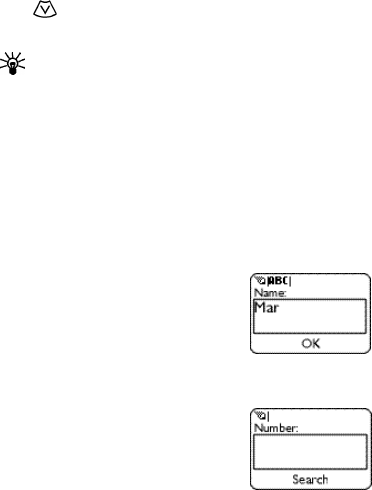
22
Finding names and numbers
There are several ways to find names and numbers in your
phone book.
From the Ready screen
Press to access your phone book, then scroll to the
desired name/number.
Tip: You can also press the number key that
corresponds to the first letter of the name. (To skip
ahead quickly in the list, press the number key that
corresponds to the first letter of the name. For
example, if you want to call your friend Katy, press the
5 key twice, quickly; once for the letter j, and once for
the letter k.) The first matching entry is displayed at
the top of the screen.
Using the Phone book menu
Press Menu 1 1, enter the first few
letters of the name, then press OK.
Your phone displays the first matching
entry at the top of the screen.
While performing other functions
Say you want to forward your phone
calls to a number that is saved in your
phone book. When you are prompted
to enter the phone number, you can
find it instead—simply press Search to
access your phone book.
Editing names and numbers
To edit phone book entries, press Menu 1 3, scroll to the
entry you want to edit, then press Edit. Edit the name and
number as needed.

23
Erasing names and numbers
Use Menu 1 6 to erase entries from your phone book.
One by one lets you select one entry at a time to be erased.
Erase all erases your entire phone book (you are required to
enter your security code first).
Finding your own number
Use Menu 1 7 to view your phone’s number.
Scrolling view
Use Menu 1 4 1 to choose a scrolling view for your phone
book (Name list, Name+number, or Name only).
Tip: If you’re viewing your phone book and scrolling
view is set to Name list or Name only, you can view
the phone number associated with a name by pressing
and holding .
Checking available memory
Use Menu 1 4 2 to see how many memory locations are free
and how many are being used. (Each memory location holds
one phone number and associated name.)
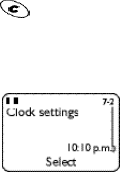
24
6. Settings
This section describes some phone settings that allow you to
customize your phone to suit your preferences and that you
probably won’t change very often.
Automatic redial
Use Menu 4 1 2 to turn this feature on or off. When this
feature is on and the wireless network is busy, your phone
redials a number up to three times. This feature does not
redial to a busy phone number.
To stop the call attempts, press Quit or .
Clock
Your phone has an internal clock that
can be displayed on the Ready screen.
If you remove the battery for longer
than a couple of seconds, the time is
lost. The next time you turn on the
phone you may be asked to enter the time, unless your
phone sets the time using the network.
Setting the time using the network
To set the time on your phone using the network (the
default setting), use Menu 7 2 2 1. If your phone is unable
to get the time from the network, you are prompted to enter
the time manually. (For example, your phone may not be
able to get the time from the network if you don’t have
digital coverage.)
Setting the time manually
Use Menu 7 2 2 2 to enter the current time. Use two digits
for both hours and minutes (for example, enter 1:30 as 0130).
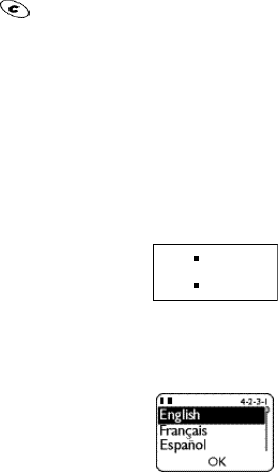
25
If the clock’s time format is set to am/pm, you are asked to
choose am or pm.
Note:Pressing does not work on this screen. If you
make a mistake, re-enter all four digits.
Selecting time format
Use Menu 7 2 3 to set the clock’s format to am/pm or
24-hour.
Displaying or hiding the clock
Press Menu 7 2 1 to display the clock on the phone’s screen
if it is currently hidden, or vice versa.
When the clock is displayed and the
time format is set to am/pm, a black
square appears next to the time
indicating a.m. or p.m.
Language
Use Menu 4 2 3 to set the language of
your phone’s screen. You can choose
from English, French, Spanish,
Portuguese, and Hebrew.
The shortcut for choosing English is to
press Menu 42 31.
Lights
If you’re using your phone with a car kit, your phone’s lights
turn on and remain on automatically. Use Menu 4 2 4 to set
your phone’s lights to Automatic (after 30 seconds, the
lights turn off until the next key is pressed, phone rings, etc.).
For information about turning your phone’s lights on at any
time, see page 9.
Note:You can only access Menu 4 2 4 once your phone has
been connected to a car kit.
03:15
03:15 3:15 a.m.
3:15 p.m.

26
Tones
Use Menu 8, Tones, to change the six sound settings in your
phone: ringing option, ringing tone, ringing volume,
message alert tone, keypad tones, and warning and game
tones.
Using the quick alert settings feature (see page 27) you can
select a fixed combination of these settings to suit your
current environment.
Ringing option
Use Menu 8 1 to tell your phone how to notify you that you
have a call.
Note:If you choose Beep once or Silent, the alarm clock
only sounds a quiet beep.
Ring The phone rings normally using the currently selected
ringing tone.
Ascending The phone rings using the currently selected
ringing tone. The ringing volume starts low and increases to
selected volume with successive rings.
Ring once The phone rings once using the currently
selected ringing tone.
Beep once The phone beeps once.
Silent The phone makes no sound when you receive a call.
The icon appears on the Ready screen.
Ringing tone
If your ringing option is set to Ring once, your phone plays a
ringing tone when someone calls you. Use Menu 8 2 to
choose one of 39. Scroll to a tone to hear how it sounds.
Note:If the ringing option is set to Silent or Beep once, the
phone won’t play sample tones.

27
Ringing volume
Use Menu 8 3 to control the volume of
your phone’s ringing and of message
alert tones.
Message alert tone
Use Menu 8 4 to choose the tone played when you receive a
text message. Scroll to a tone to hear how it sounds.
Keypad tones
Use Menu 8 5 to adjust the volume of the tones your phone
makes when you press its keys.
Warning and game tones
Use Menu 8 6 to turn your phone’s warning and game tones
on or off. Warning tones are created by events such as
confirmations, errors, power on, battery low, and recharge
battery.
Vibrating alert
If your phone has a vibrating battery attached, use Menu 8 7
to set your phone to vibrate when you receive a voice call.
If you turn vibrating alert on, your phone vibrates even if its
ringing option is set to Silent.
Note:The vibrating battery does not vibrate when your
phone is connected to or placed in any charging device, or if
it’s connected to a car kit.
Quick alert settings
You can quickly adjust your phone’s
sound settings when you go into a
meeting, go outdoors, etc. To choose a
quick alert setting, briefly press ,
scroll to the setting you want, then
press OK.

28
Note: You can only access your phone’s quick alert settings
from the Ready screen.
Tip: Instead of using the scroll keys, you can press
repeatedly to scroll through this menu. After you
reach the setting you want, press and hold .
Note: If you choose Silent or Quiet, the alarm clock only
sounds a quiet beep.
Normal Your phone uses the settings you made in Menu 8,
Tones.
Silent All sound is turned off in your phone. The icon
appears on the Ready screen.
Quiet Your phone beeps once when you receive a call or
text message. Other tones are turned off.
Loud Your phone rings loudly. Keypad tones, message alert
tone, and warning tones are also loud.
Headset Your phone automatically selects this when it is
connected to a headset. Your phone remembers any changes
you make to settings in Menu 8, Tones, and uses them the
next time you connect the phone to a headset.
Car Your phone automatically selects this when it is
connected to a car kit. Your phone remembers any changes
you make to settings in Menu 8, Tones, and uses them the
next time you connect the phone to a car kit.
Note:If the Silent, Quiet, or Loud quick alert setting is
chosen and you change a setting in Menu 8, Tones, your
phone switches the current quick alert setting to Normal.
To return to the Ready screen, press .
Voice mailbox number
If you have a voice mail subscription, use Menu 2 2 2 to
save the voice mailbox number given to you by your service
provider. This number may be up to 32 digits long. Once you
save your voice mailbox number, you can press and hold
for 3 seconds to dial your voice mailbox. (You can also
press briefly and then press Call.)

29
For more information, see ‘Voice messages’ on page 47.
For any questions about your voice mail, contact your
service provider.
Welcome note
Use Menu 2 3 to create or change the
welcome note for your phone. This
note is displayed briefly each time you
turn on your phone. It can be your
name, a reminder, etc. To save the
note, press Options, then Save. To erase the note, press
Options, then Erase.

30
7. Emergency calls
1If the phone is not on, switch it on.
2Press and hold for several seconds to ready the
phone for calls.
3Key in the emergency number for your present location
(e.g. 911 or other official emergency number).
Emergency numbers vary by location.
4Press Call.
IMPORTANT!
This phone, like any wireless phone, operates using radio
signals, wireless and landline networks as well as user-
programmed functions which cannot guarantee connection
in all conditions. Therefore you should never rely solely upon
any wireless phone for essential communications (e.g.
medical emergencies).
Remember, to make or receive any calls the phone must be
switched on and in a service area with adequate signal
strength. Emergency calls may not be possible on all wireless
phone networks or when certain network services and/or
phone features are in use. Check with local service providers.
If certain features are in use (Keyguard, call restrictions, etc.),
you may first need to turn those features off before you can
make an emergency call. Consult this document and your
local cellular service provider.
When making an emergency call, remember to give all the
necessary information as accurately as possible. Remember
that your wireless phone may be the only means of
communication at the scene of an accident - do not cut off
the call until given permission to do so.
31
Emergency key 9
Use Menu 4 1 1 to turn on this feature. When this feature is
on, the phone attempts to make an emergency call when
you:
•press and hold the 9 key, or
•press 9, then press Call.
Note:When Keyguard is active, the only way to make an
emergency call is to dial the emergency number, then press
Call.
IMPORTANT!
Official emergency numbers (for example, 911) vary by
location. Only one number is dialed automatically by
Emergency Key 9, and it might not be the proper number in
all circumstances.
32
8. Advanced functions
Network feature setting
Call forwarding, call waiting, and send own number are
network services available through your service provider.
These features do not appear in your phone’s Network
services menu until you save the related feature code(s)
given to you by your service provider. After you save the
feature activation or cancellation code, the feature appears
in the phone’s menu and you can use the menu to turn the
feature on or off.
Note:Feature codes can be saved only when your primary
phone number (NAM 1) is selected. See page 39.
Adding feature activation codes to the menu
To save a feature activation code, press Menu 4 4 4. At the
Feature code: prompt, enter the feature activation code,
then press OK. Scroll to the feature that the code applies to,
then press Select. (If the feature is call forwarding, choose
one of the four types of call forwarding.) Finally, scroll to
Activate, then press OK.
Activate now appears in the menu for that feature.
Adding feature cancellation codes to the
menu
To save a feature cancellation code, press Menu 4 4 4. At
the Feature code: prompt, enter the feature cancellation
code, then press OK. Scroll to the feature that the code
applies to, then press Select. (If the feature is call
forwarding, choose one of the four types of call forwarding.)
Finally, scroll to Cancel, then press OK.
Cancel now appears in the menu for that feature.

33
In-call menu
When you are in a single call, the Navi™ key function is End.
However, you can use your phone’s in-call menu to perform
several functions while in a call. To access the in-call menu,
press to change the Navi™ key function to Options,
then press Options.
Note:If you have an active call and an incoming or held call,
pressing isn’t necessary; Options appears
automatically.
Depending on the number of active calls and whether you
are using digital or analog mode, the following in-call
options may be available:
Making/receiving multiple calls
Note:The following two features might not be supported in
your network. Contact your service provider for details.
Making a new outgoing call
Type in the phone number you wish to call and press
Options to access the in-call menu. Then, press Flash.
The first call is automatically put on hold. To join the calls,
press Flash again.
Receiving a new call
When you are in a call and you receive a call, the Navi™ key
function varies depending on whether you are in digital or
analog mode:
Mute/End
mute mute/unmute the phone’s microphone
Flash switch between calls/answer waiting call/
make new call
End end all calls
Touch tones send touch tones
Menu access your phone’s menu
Phone book access the phone book

34
Digital
The Navi™ key function changes to Answer. Once you
answer the new incoming call, the Navi™ key function
changes to Options. To swap between the calls, press Flash.
Analog
The Navi™ key function remains End. Press to change
the Navi™ key function to Options to access the in-call
menu. Then, press Flash. The first call is automatically put
on hold. To swap between the calls, press Flash again.
Ending all calls
Select End from the in-call menu.
Call waiting
Call waiting is a network service that allows you to receive
an incoming call when you’re already in a call. Contact your
service provider for details.
Answering a waiting call
When you receive a call while already in a call, the Navi™
key function changes from End to Answer. Press Answer to
answer the waiting call. The call you were in is put on hold,
and the Navi™ key function changes to Options. To switch
between calls, or to end all calls, press Options to access
your phone’s in-call menu.
For complete information on your phone’s in-call menu, see
‘In-call menu’ on page 33.
Cancelling call waiting: normal method
To cancel call waiting before making a call, you must get
the call waiting cancellation code from your service
provider.
1Dial the code for cancelling call waiting (for example,
*810).
2Press Call.

35
Cancelling call waiting: menu method
You can save the code for cancelling call waiting given by
your service provider and then use Menu 44 2 2 to cancel
call waiting. See ‘Adding feature cancellation codes to the
menu’ on page 32.
Calling cards
If you wish to use a calling card for
long distance calls, you must first save
your calling card information into your
phone. Your phone can save
information about four calling cards.
Saving calling card information
1Press Menu 4 1 3.
2Scroll to the desired calling card, then press Options.
3Scroll to Edit, then press OK.
4Enter your security code (see page 55), then press OK.
5At Dialing sequence, press Select. Press to choose
the dialing sequence your card uses, then press Select.
Dialing
sequence Use for cards that
require you to: Cards using
this sequence
Access no.
+ phone no.
+ card no.
Dial 1-800 access number,
then phone number, then card
number (+ PIN if required)
MCI, AT&T
True Choice,
Sprint Canada,
Unitel
Access no.
+ card no.
+ phone no.
Dial 1-800 access number,
then card number (+ PIN if
required), then phone number
networkMCI,
WorldPhone
MCI
Prefix
+ phone no.
+ card no.
Dial the prefix (any numbers
that must precede the phone
number) and phone number
you want to dial, then card
number (+ PIN if required)
GTE, PacBell,
AT&T, Stentor

36
Note:The order of the following steps may vary, depending
on which dialing sequence your card uses.
6Enter the access number (usually the 1-800 number
listed on the back of the calling card), then press OK.
7Enter your card number and/or PIN, then press OK. Your
phone will display Save changes? Press OK.
8Press to reach Card name, then press Select. Enter
the card name using your phone’s keypad, then press OK.
Note:This procedure might not work with all calling cards.
Please look at the back of your calling card or contact your
long distance company for more information.
Choosing a calling card to use
Use Menu 4 1 3 to select a calling card to use. You are
required to enter your security code.
Calling card calls
To make a call using a calling card:
1Enter the phone number, including any prefix (such as 0
or 1) that your calling card may require when you make
a calling card call (see your calling card for instructions).
2Press and hold Call for a few seconds until your phone
displays Card call.
3Your phone displays Wait for tone, then press OK. Wait
for the tone, then press OK.
Your phone displays Wait for tone, press OK again. Wait
for the tone again, then press OK.
Call forwarding
Call forwarding is a network service that lets you forward
your incoming calls to another phone number. Check with
your service provider for details and feature codes.
37
Activating call forwarding
Standard method
To activate call forwarding, you must get the call forwarding
activation code from your service provider.
1Dial the code for activating call forwarding followed by
the phone number to which you want to forward your
calls.
2Press Call.
Example:If the call forwarding activation code is *71 and
the number you want to forward calls to is (214) 555-1234,
dial *712145551234, then press Call.
Menu method
You can save the code for activating call forwarding and
then use the menu to activate call forwarding (see ‘Adding
feature activation codes to the menu’ on page 32).
Cancelling call forwarding
Standard method
To cancel call forwarding, you must get the call forwarding
cancellation code from your service provider.
1Dial the code for cancelling call forwarding (for example,
*710).
2Press Call.
Menu method
You can save the code for cancelling call forwarding and
then use the menu to cancel call forwarding (see ‘Adding
feature cancellation codes to the menu’ on page 32).

38
1-touch dialing
1-touch dialing lets you make phone calls quickly and easily
with the touch of a button. Once you have assigned a phone
number to a number key (2 through 8), you can press and
hold that key to dial the number. (You can also press and
hold the number key and then press Call.)
Note:Keys 1 and 9 are used exclusively for dialing your voice
mailbox and for attempting emergency calls, respectively
(see ‘Voice messages’ on page 47 and ‘Emergency calls’ on
page 30).
Assigning numbers to keys
Before you can assign a phone number to a key, the phone
number must be saved in your phone book (see page 19).
Then follow the steps below.
1Press Menu 1 5.
2Scroll to the desired key, then press Assign.
3Press or to choose the name you want to assign
to the selected key, then press Select.
If a key already has a number assigned to it, you can press
Options and then view, change, or erase the number
assignment.
Making calls using 1-touch dialing
Press and hold a number key (2 through 8) for a few seconds
to call the number assigned to it. Your phone finds the
phone number, displays it briefly, then dials it.
You can also enter the number of the 1-touch dialing key
(for example, 2) and press Call.
39
Choosing your phone number
(NAMselection)
Note:Your phone may not be able to support more than one
phone number. Please contact your service proivder for
details.
Your service provider can set up your phone to have two
phone numbers that are activated in different service
areas—for example, one number for the Dallas area and one
number for the Chicago area.
A number assignment module, or NAM, consists of a phone
number and network information that the service provider
programs into your phone. When you select a NAM, you’re
not only selecting a phone number, you’re also selecting a
home system in which you will not be charged roaming fees.
Use Menu 4 4 5 to select a NAM.
Send own number
Send own number is a network service that lets you hide
your phone number from a person you are calling who has
Caller ID. (If for some reason your network prevents phone
numbers from being displayed, you may be able to use this
feature to show your number to the person you are calling.)
Contact your service provider for feature codes for showing/
hiding your phone number.
Standard method
1Dial the feature code followed by the number you want
to call.
2Press Call.
Example:If the feature code to hide your number is *67 and
the number you want to dial is (214) 555-1234, dial
*672145551234, then press Call.

40
Menu method
You can save the feature code given to you by your service
provider so that Send own number appears in your phone’s
menu, and then use Menu 4 4 3 to use this feature
(see ‘Network feature setting’ on page 32).
This feature must be activated before each call; you cannot
permanently turn it on or off.
Yes displays your number to the person you are calling.
No prevents your number from being shown to the person
you are calling.
NAM update
Note:This feature may not be available in all systems.
Please conotact your service provider for details about the
availability of this feature.
With this feature you can activate or reactivate your phone
without having to go to your service provider. Please refer to
the Easy Activation card that was included in your sales
package for more information on how to activate or
reactivate your phone.
In some cases, when you try to connect to your service
provider, the following message may appear on the screen:
‘LOCK’ prevents the service provider from changing your
carrier lock code. ‘UNLOCK’ allows the provider to change
the code and restrict others from activating your phone.
If this happens, select the appropriate selection for your
phone. If you don’t want your service provider to change
your lock code, select LOCK. If you want to allow your
service provider to change your code to prevent other
service providers from activating your phone, press
UNLOCK.
Press and hold for several seconds to return to the
Ready screen.
Note:Contact your service provider if you have any
questions.
41
System
Using System, you can choose how your phone selects a
network to use. This feature is Menu 5 in your phone. You
have options for System search selection and Digital/analog
selection.
System search selection
Under System search selection any of the following four
options may appear, depending on your service provider:
•Automatic - your phone automatically searches for
networks available to you and chooses the appropriate
one. This is the default setting.
•SemiAuto A - your phone uses system A unless a home
or preferred system is available.
•SemiAuto B - your phone uses system B unless a home
or preferred system is available.
•Home area - your phone does not go into roam mode,
and you will not be billed roaming charges.
Digital/analog selection
Under Digital/analog selection you have the following three
options:
•Digit. & analog - your phone places a call using either a
digital or analog system. If digital service is unavailable,
the phone will automatically switch to an available
analog system. This is the defaut setting.
•Digital - your phone places a call using an available
digital system.
•Analog - your phone places a call using an available
analog system.
Note:Once you turn your phone off and back on, the phone
returns to the default setting of Digit. & analog.

42
Anykey answer
This feature allows you to answer an incoming call by
pressing any key except . Use Menu 4 1 5 to turn this
feature on or off.
Automatic answer
This feature is available only when your phone is connected
to a headset or to an approved handsfree car kit equipped
with the ignition sense option, with the ignition on.
When automatic answer is turned on, your phone answers
incoming voice calls after one ring. Use Menu 4 1 4 to turn
this feature on or off.
Touch tones
Your phone can generate various sounds, called touch tones,
when the keys are pressed.
Touch tones can be used for many automated services such
as checking voice mail, movie times, and airline arrival/
departure times.
Note:Sending confidential information over the air using
touch tones is not recommended.
Setting manual touch tone length
Use Menu 42 1 1 to set the length of touch tones created
when you press a key:
Continuous sounds the tone for as long as you press and
hold the key.
Fixed sets the tone length to one tenth of a second,
regardless of how long you press and hold the key.
Off turns off touch tones. No tones are sent when you press
the keys.

43
Setting automatic touch tone length
Use Menu 42 1 2 to set the length of touch tones sent
automatically by the phone to Short (one tenth of a second)
or Long (half a second).
Saving touch tone strings
Touch tone strings can be used for sending and receiving
information with your phone. Save touch tone strings the
same way you save phone numbers (see ‘Saving names and
numbers’ on page 21).
For example, you can save your office voice mailbox number
along with your password for easy access to your messages
(see ‘Special characters in phone numbers’ on page 14).
Sending touch tone strings
1During a call, press to clear any numbers from the
screen.
2Press Options.
3Scroll to Touch tones, then press OK.
4Enter or find the touch tone string, then press OK.
Restore factory settings
You can use Menu 4 2 2 to reset many of the settings in
your phone to their factory defaults (as in a new phone).
You are required to enter the security code.
Note:The phone book, language setting, call timers, security
code, and lock code are not affected.
44
9. Call log
For your convenience, the call log (Menu 3) saves a list of
phone numbers you have dialed, and can show you
approximately how much time you have spent on the phone.
If you subscribe to the caller ID network service, the call log
also records the phone numbers of missed calls and received
calls. Contact your service provider for details.
The Options key
When you access Missed calls, Received calls, or Dialed
calls and press Options, a list of options appears on your
phone’s screen.
Call dials the number.
Call time shows the time of the call. (Your phone’s clock
must be set; see page 24.)
Use number shows you the number before you dial it.
Save lets you enter a name for the number, edit the number
if needed, and save both to your phone book.
Erase erases the number from the call list.
View number displays the associated phone number if only
the name is currently displayed.
Missed calls
If you subscribe to the caller ID network service, your phone
automatically stores the last 10 numbers that have tried
unsuccessfully to reach you (as long as the caller allowed
his or her number to be shown to you).
When the screen says Missed calls
Press List. If you have missed more than one call, you can
scroll through the list of numbers. To dial the displayed
number, press Options, then choose Call.
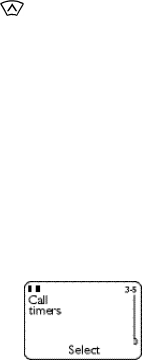
45
Viewing the missed calls list at any time
Use Menu 3 1 to view the missed calls list at any time. To
dial a number, press Options, then choose Call.
Received calls
If you subscribe to the caller ID network service, your phone
automatically stores the phone numbers of the 10 most
recent calls you’ve answered. Use Menu 3 2 to view the
received calls list. To dial a number, press Options, then
choose Call.
Dialed calls
Your phone automatically stores the last 10 numbers you’ve
dialed. From the Ready screen, press to access the
dialed calls list. Scroll to the desired number, then press
Call.
Note:To perform any of the options listed on page44, access
the dialed calls list by pressing Menu 33.
Clearing call lists
Use Menu 3 4 to clear the missed, dialed, and/or received
call lists.
Call timers
Use Menu 3 5 to access this feature.
Call timers lets you see the amount of
time you’ve spent in calls. Times are for
the currently selected phone number;
your phone has a separate timer for
each phone number, or NAM (see page 39).
Note:The actual time invoiced for calls by your service
provider may vary, depending upon network features,
rounding-off for billing, and so forth.
46
Viewing call timers
Use Menu 3 5 to view the various call timers.
Last call displays the duration of the last call, or current call
if applicable.
All calls displays the duration of all calls since the timers
were last reset.
Life timer displays the duration of all calls for the life of
your phone and cannot be reset.
Setting timers back to 0
Use Menu 3 5 4 to clear call timers. You are required to
enter your security code.
Displaying the current call timer during calls
1Press Menu 3 5 1.
2Press Details.
3Press Select.
4Scroll to On, then press OK.
Once a call has ended, the amount of time spent in that call
is displayed for ten seconds.

47
10. Voice messages
Voice mail is a network service that allows callers to record
a message when you cannot be reached. You can then call
your voice mailbox and retrieve your messages.
Saving your voice mailbox number
When you subscribe to voice mail, your service provider
gives you a voice mailbox number. You should save this
number so you can call your voice mailbox by pressing and
holding , or by pressing then Call (see ‘Voice
mailbox number’ on page 28).
In addition to a voice mailbox number, your service provider
may also give you a password, which you can save along
with your voice mailbox number. This way, you can access
your voice mailbox and then quickly send your password by
pressing the Navi™ key rather than dialing your password
separately.
If your service provider gives you a password and you want
to save it with your voice mailbox number, refer to ‘Special
characters in phone numbers’ on page 14.
Listening to new voice messages
When you receive a voice message, your phone may notify
you by beeping, displaying the voice message indicator
, and displaying New voice message. The phone may
display the number of messages if there is more than one.
Note:The method of notification depends on your service
provider.
When your phone notifies you that you have a new voice
message, press Listen. Your phone dials your voice mailbox
number, if you have saved it.
If you received a voice mailbox password, and if you saved it
with your voice mailbox number, follow these steps:

48
1When your phone notifies you that you have a new voice
message, press Listen. Your phone dials your voice
mailbox number, and your password displays.
2When your phone notifies you that you’re able to listen
to your messages, press Send.
Note:The method of notification depends on your service
provider. If you have any questions about voice messaging,
contact your service provider.
Calling your voice mailbox at any time
Once you have saved your voice mailbox number, you can
press and hold to dial your voice mailbox.

49
11. Text messages
With the text message network service you can receive text
messages from a variety of sources, such as another wireless
phone or a Web site set up by your service provider.
Your phone can handle messages of up to about 250
characters, and has space to receive up to about 30
messages, depending on the length of each one.
Contact your service provider for more information about
this network service.
Reading messages
When you receive a text message, the phone displays the
indicator, either Message received or New
emergency message (if an emergency message has been
received), and makes a sound (depending on the message
alert tone; see ‘Message alert tone’ on page 27).
To read the message, press Read. This takes you to the
Inbox, with the new message selected. Press Read again. If
necessary, use the scroll keys to read the entire message.
After reaching the end of the message, use the scroll keys to
view the sender’s name or phone number, and the date and
time the message was received.
Options when reading messages
Several options are available while you’re reading a
message. Just press Options, scroll to the one you want,
then press OK.
Erase deletes the message. Press OK to confirm the deletion
(or to cancel).
Use number calls any phone number included in the
message. If more than one number was included, a list of
numbers is displayed. Choose one and press Call.
Save saves the message in the Saved folder.

50
When you’ve seen the last new message, the indicator
disappears.
About the Inbox
The Inbox holds text messages that have not been deleted or
saved. Use Menu 211 to access the Inbox at any time (you
are required to enter your security code first).
You see a list of message headers. The icon in front of
the header indicates that a message has been read. The
icon indicates that a message has not been read. Scroll to
the desired message, then press Read.
About the Saved folder
The saved folder holds up to 30 saved text messages and a
total of 2000 characters. Use Menu 2 1 2 to access the
Saved folder and read saved messages (you are required to
enter your security code first).
About the Erase all option
Erase all allows you to erase all text messages, or you can
erase all messages in either the Inbox or the Saved folder.
You are required to enter your security code before erasing
all messages. Unread text messages are not erased.
Storage of incoming messages
When you have an incoming text message and your phone’s
memory is full, one or more low-priority messages are
automatically deleted in order to receive the new text
message. Messages are usually deleted from your Inbox, but
an emergency message may cause messages to be deleted
from the Saved folder.
If the message memory is still full, your phone displays No
space: message waiting. You can clear this notification by
pressing OK. You should delete one or more old messages to
make room for the new message. The network will re-send
the message at a later time.

51
12. Extra features
Alarm clock
The alarm clock feature sounds an
alert at a time you specify.
Setting the alarm clock
Use Menu 7 1 to turn the alarm clock on or off.
Note that when you’re entering the alarm time, use two
digits for both hours and minutes (for example, enter 1:30
as 0130).
Note: Pressing does not work on this screen. If you
make a mistake, re-enter all four digits. Press up or down on
the scroll keys to move the cursor. The number you press is
entered to the right of the cursor.
Alarm volume
The alarm volume is determined by the current ringing
volume. However, if you have manually set the ringing
option (see page 26) to Silent or Beep once or have selected
the Silent or Quiet quick alert setting (see page 27), the
phone only sounds a quiet beep.
When the alarm sounds
•To shut off the alarm, pressany key except Snooze.
•If you press Snooze, the alarm sounds again in ten
minutes. To turn off the alarm before then, press Stop.
•If you let the alarm sound for one minute without
pressing a key, it stops for ten minutes, then starts
again.
52
If you turn off the phone
If you turn off the phone and the alarm is set, the phone
switches itself on at alarm time, then the alarm sounds.

53
•To shut off the alarm, press any key except Snooze.
The phone displays Keep the phone on?. Press Yes to
keep it on or to switch it off.
•If you press Snooze, the phone turns itself off for ten
minutes, then the alarm sounds again.
REMEMBER! Do not switch on the phone when wireless
phone use is prohibited or when it may cause interference or
danger.
Games
Use Menu 6 to challenge yourself or a friend to the three
fun games in your phone. To pause a game, press .
To resume, choose Continue.
REMEMBER! Your phone must be switched on to use this
function. Do not switch on the phone when wireless phone
use is prohibited or when it may cause interference or
danger.
Memory
Reveal pictures to find pairs in as few tries as possible.
Move the cursor with the 2 (up), 4 (left), 6 (right), and
8 (down) keys. Press the 5 key to reveal pictures. Once found,
pairs stay visible. Press to jump to the right over
revealed pictures or to move from the bottom right of the
screen to the top left. Press to jump to the left over
revealed pictures or to move from the top left of the screen
to the bottom right.
Snake
Feed the snake with as many goodies as possible and watch
it grow. Use keys 2, 4, 6, and 8 to turn the snake toward
food. The longer the snake’s tail grows, the higher your
score. If the snake hits its own tail or the surrounding wall,
the game is over.
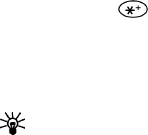
54
Logic
Find the secret combination of figures in a column.
Possible figures are shown at the top of the screen. Press
the 5 key repeatedly to select a figure and the 2, 4, and 8
keys to move the cursor. Once you think you have the right
combination, press . The result appears as a set of
marks above the column. A correct figure in the right place
gets a full mark; a correct figure in the wrong place gets a
half mark. The game ends when the correct figures are in
the right place.
Tip: To copy a figure from the previous column, move
the cursor over it using the 2, 4, or 8 key, then press
the 5 key.
55
13. Security features
Access codes overview
Access codes consist of the lock code and security code.
When you get your phone, you should change these codes
from their defaults, write down the new codes, and keep
them in a safe place away from the phone. Avoid using
access codes that are similar to emergency numbers, such as
911, to prevent accidental dialing of the emergency number.
Lock code
Your phone’s lock code is used to lock and unlock your
phone. The default lock code is 1234. Use Menu 4 3 2 3 to
change the lock code.
When the phone requires the lock code, it displays Enter
lock code:.Enter the code, then press OK.
If you enter a wrong lock code five times in succession, your
phone prompts you for the security code.
Security code
The security code is required to restrict calls and to restore
factory settings. The default security code is 12345.
Use Menu 4 3 2 4 to change the security code.
When the phone requires the security code, it displays
Security code: Enter the code, then press OK.
If you enter an incorrect security code five times in
succession, the phone will not accept any input for the next
five minutes.
Restricting calls
Use Menu 4 3 1 to restrict outgoing or incoming calls.
This is handy if you want to lend your phone to someone but
don’t want them to make long-distance or other expensive
calls.
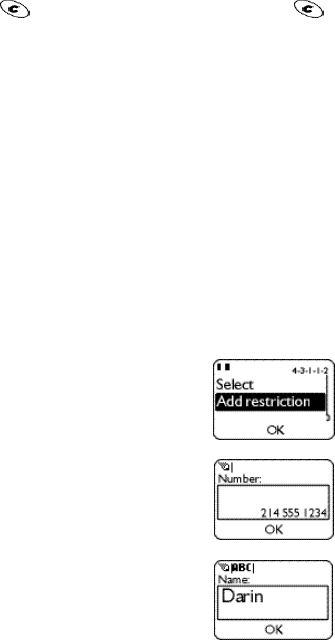
56
Restricting incoming calls
You can block all incoming calls or create a list of incoming
numbers from which you don’t want to receive calls.
To block all incoming calls, enter your security code, scroll
to Select and press OK, then press Mark.
Press Unmark if you want to remove the restriction.
Press , then press Yes to save your changes (or
to cancel).
Note: This feature requires the caller ID network service, and
the caller’s ID must be available to the phone in order for the
restriction to work.
Adding numbers to the restricted incoming calls list
A call restriction can consist of an entire phone number, just
an area code, etc. When the restriction is selected, calls
cannot be received from any number beginning with those
digits. For example, entering 2145551234 blocks calls
from (214) 555-1234 only. 214 blocks all calls from the 214
area code.
To create a list of incoming numbers from which you don’t
want to receive calls, enter your security code, then press
OK. Continue with the steps illustrated below.
1 Scroll to Add restriction, then
press OK.
2Enter the phone number, area code,
etc. of the number from which you
want to restrict calls, then press
OK.
3If you want, give a name of up to
10 characters to the restriction
(such as Joey), then press OK.
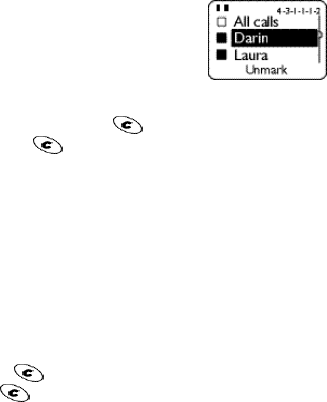
57
The entry is added to your list of restricted numbers.
Your phone can save up to 15 restricted incoming
numbers. Once you enter 15 restricted numbers, the Add
restriction option is removed from the menu. This option
is available again once you delete one or more phone
numbers from the restricted list.
Note: Your phone does not alert you to incoming calls from
restricted numbers unless the caller leaves a voice message.
Making changes to the restricted incoming calls list
To edit or completely erase an entry in the list, choose Edit
or Erase, select the entry you want to edit or erase, and
follow the instructions on the screen.
Allowing calls from a number on the list
If you later decide to allow calls to a
restricted number, scroll to Select and
press OK to see your list of numbers.
Press Unmark to remove the
restriction. (The number remains in the
list so that you can restrict it again later by pressing Mark.)
When you’re done, press . Press Yes to save your
changes (or to cancel).
Restricting outgoing calls
You can block all outgoing calls or create a list of numbers
to which outgoing calls cannot be made. To block all
outgoing calls,
1Enter your security code and press OK.
2Scroll to Select and press OK.
3With All calls highlighted, press Mark.
4Press , then press Yes to save your changes
(or to cancel).
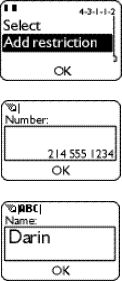
58
Adding numbers to the restricted outgoing calls list
A call restriction can consist of an entire phone number, an
area code, etc. When the restriction is selected, calls cannot
be made to any number beginning with those digits.
For example, entering 2145551234 blocks calls to (214)
555-1234 only. 1 blocks all calls starting with 1, including
long distance calls and 1-800 calls. 1800 blocks 1-800 calls
only.
To prevent your phone from making outgoing calls, scroll to
Add restriction and press OK. Continue with the steps
illustrated below.
1Scroll to Add restriction, then
press OK.
2Enter the phone number, area code,
etc. to which you want to restrict
calls, then press OK.
3If you want, give a name of up to
10 characters to the restriction
(such as Joey, Long dist, or 1-800
#s), then press OK.
The entry is added to your list of
restricted numbers. Your phone
can save up to 10 restricted outgoing numbers. Once you
enter 10 restricted numbers, the Add restriction option
is removed from the menu. This option is available again
once you delete one or more phone numbers from the
restricted list.
Making changes to the restricted outgoing calls list
To edit or completely erase an entry in the list, choose Edit
or Erase, select the entry you want to edit or erase, and
follow the instructions on the screen.

59
Allowing calls to a number on the list
If you later decide to allow calls to a
restricted number, scroll to Select and
press OK. You can now see your list of
numbers. Press Unmark to remove the
restriction. (The number remains in the
list so that you can restrict it again later by pressing Mark.)
When you’re done, press . Press Yes to save your
changes (or to cancel).
Phone lock
You can prevent unauthorized use of your phone by locking
it. When your phone is locked, only incoming calls and calls
to the unlocked phone number (see below) are allowed. The
memory and menu are unavailable.
Note:Calls may still be possible to emergency numbers.
How to lock your phone
Press Menu 4 3 2 1. Enter the lock code (see page 55), then
press OK. Scroll to On, then press OK.
How to unlock your phone
Press Menu, enter the lock code, then press OK.
Answering a call when the phone is locked
Press Answer.
Saving the unlocked phone number
Use Menu 4 3 2 2 to save a number that may be called even
when your phone is locked. You are required to enter the
lock code.
Calling the unlocked phone number
Press or , or manually enter the number exactly as it
is saved, then press Call.
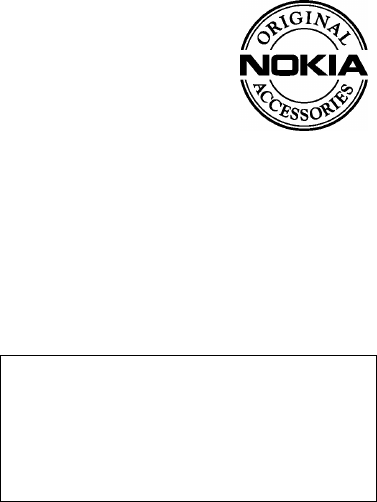
60
14. Accessories
An extensive range of accessories
is available for your phone. You
can select the accessories that best
suit your specific communication
needs. For availability, see your
local authorized Nokia dealer.
A few practical rules for accessory
operation:
•Keep accessories out of small children's reach.
•When you disconnect the power cord of any accessory,
grasp and pull the plug, not the cord.
•Check regularly that all wireless phone equipment in
your vehicle is mounted and operating properly.
•Installation of complex car equipment must be
completed by qualified personnel only.
Nokia Xpress-on™ color covers
Your phone’s Xpress-on™ cover is available in several
fashion colors. Extra covers may be purchased from your
authorized Nokia dealer.
Note:Always store your phone with the cover attached.
WARNING!
Use only batteries, chargers and accessories approved by
the phone manufacturer for use with this particular phone
model. The use of any other types may invalidate any
approval or warranty applying to the phone, and may be
dangerous.
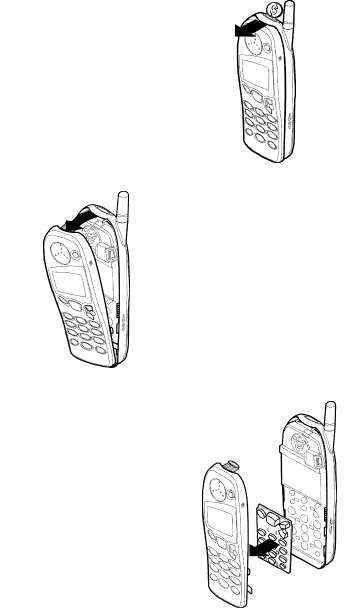
61
Changing covers
When changing covers, don’t use the phone’s antenna as
leverage!
1Switch off the power and disconnect the phone from
the charger or any other device.
2Using a coin, depress the
colored tab on the top of
the phone and slide the
color cover forward.
3Remove the cover.
4Remove the rubber
keypad from the back of
the cover. Place it into
the back of the new
cover.

62
5Place the bottom of the
cover against the
bottom of the phone.
Make sure all three sets
of plastic tabs line up
with their respective
slots, as shown at left.
Close the cover and snap
it shut all the way
around the edge of the
phone.
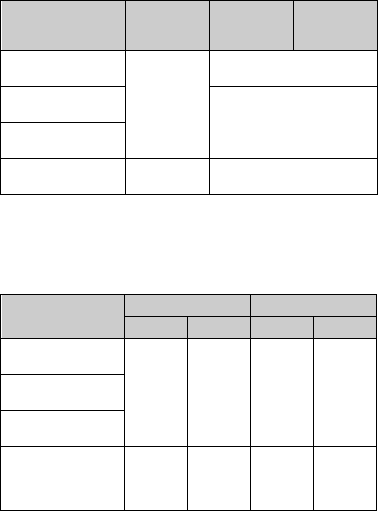
63
Batteries
Several batteries are available for your phone:
•BLS-2 Extended Li-Ion 900 mAh
•BMS-2S Extended NiMH 900 mAh
•BMS-2V Vibrating NiMH 900 mAh
•BLS-4 Ultra Extended Li-Ion 1500 mAh
Charging times
The table below displays approximate battery charging times.
These charging times charge your phone to about 80% of
its capacity, and the battery strength indicator stops
scrolling. If you wish to obtain 100% battery capacity,
please allow another two hours for “maintenance” charge.
Talk and standby times
The table below displays approximate talk and standby times.
Variations occur depending on network settings and usage.
Battery Standard
Travel Charger
ACP-7U
Rapid Travel
Charger
ACP-9U
Rapid Cig.
Lighter
Charger LCH-9
BLS-2 Extended
Li-Ion 900 mAh
4 hours
2 hours
BMS-2S Extended
NiMH 900 mAh 1.5 hours
BMS-2V Vibrating
NiMH 900 mAh
BLS-4 Ultra Extended
Li-Ion 1500 mAh 5-6 hours 3.5 hours
Battery Talk Time Standby Time
Digital Analog Digital Analog
BLS-2 Extended
Li-Ion 900 mAh 2 hrs -
2 hrs,
55 min
40 min -
1 hr,
25 min
70 hrs -
110 hrs 10 hrs -
15 hrs
BMS-2S Extended
NiMH 900 mAh
BMS-2V Vibrating
NiMH 900 mAh
BLS-4 Ultra Extended
Li-Ion 1500 mAh 3 hrs,
20 min -
4 hrs,
50 min
1 hr,
10 min -
2 hrs,
25 min
115 hrs -
180 hrs 15 hrs -
23 hrs

64
Chargers and other accessories
WARNING!
This apparatus is intended for use when supplied with power
from the Standard Travel Charger (ACP-7U), Rapid Travel
Charger (ACP-9U), or Rapid Cigarette Lighter Charger
(LCH-9). Other usage will invalidate any approval given to
this apparatus and may be dangerous.
The following chargers and other accessories are available
for your phone; please see your dealer for details. Also, refer
to any accessory options manual that may have been
included in your sales package for the entire line of Nokia
Original Accessories.
Note:When a charger is not in use, disconnect it from the
power source. Do not leave the battery connected to a charger
for longer than a week, since overcharging may shorten its
life. If left unused, a fully charged battery will discharge itself
over time.
ACP-7U Standard Travel Charger
Use this durable and economical
charger to charge all battery
options. Plug the charger into a wall
outlet and connect the connector to
the bottom of your phone. Check the
charging status on your phone’s
screen.
Calls can be made during charging, but charging will stop
for the duration of the call and the battery bar scrolling
stops.
Note:If the battery is completely empty, you cannot use the
phone until it has enough charge to operate.
The Standard Travel Charger is available for different
voltage levels and can also be used with the DCH-9
Compact Desktop Charging Stand.

65
ACP-9U Rapid Travel Charger
The extremely light, functionally
designed Rapid Travel Charger charges
your phone battery quickly.
Plug the charger into a wall outlet and
connect the connector to the bottom of
your phone. Check the charging status
on your phone’s screen. You can use
your phone while charging.
Operating within a voltage range of
100V-240V AC (50Hz-60Hz), the Rapid Travel Charger is
practically voltage-independent in normal office and
household use. Like the Standard Travel Charger, the Rapid
Travel Charger is compatible with all battery options.
The Rapid Travel Charger can also be used with the DCH-9
Compact Desktop Charging Stand.
LCH-9 Rapid Cigarette Lighter Charger
Using the multivoltage Rapid
Cigarette Lighter Charger, you
can charge your phone when
you travel. The small charger's
functional design fits well with
most car lighters and interiors.
Charging times are the same as for the Rapid Travel Charger
ACP-9U. Calls can be made during charging.
A green light indicates that the Rapid Cigarette Lighter
Charger is ready to charge. Check the charging status on
your phone’s screen. The input voltage is 12 or 24 V DC,
negative grounding.
The Rapid Cigarette Lighter Charger can be used with all
accessories available for your phone.
Avoid prolonged charging with the Rapid Cigarette Lighter
Charger when the car engine is not running. This may cause
the battery of your car to drain.
Note: In some cars the cigarette lighter plug is not provided
with power when the ignition is switched off. Verify that the
green LED light is lit.
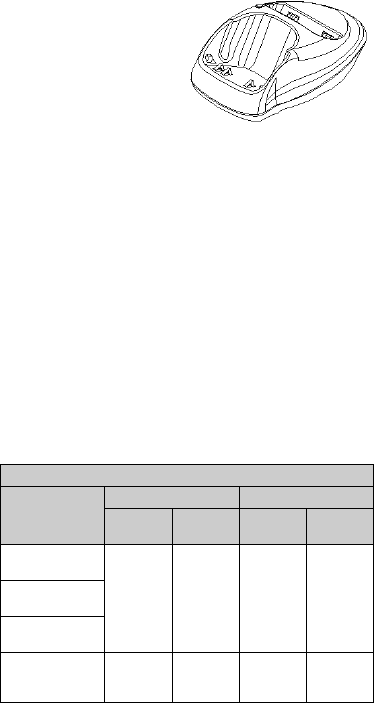
66
DCH-9 Compact Desktop Charging Stand
Compatible with all
battery options, the
Compact Desktop
Charging Stand can be
used with the Standard
Travel Charger ACP-7U
or the Rapid Travel
Charger ACP-9U. The
Compact Desktop Charging Stand provides mounting for
both the phone and a spare battery. Plug the charger into a
wall outlet and connect the connector to the back of the
Compact Desktop Charging Stand. Place your phone and/or
a spare battery in the stand to begin battery charging.
When the phone is charging, no lights are displayed on the
stand; check the charging status of the phone battery on
your phone’s screen.
Charging moves to the rear slot once the front battery is
100% charged.
When the spare battery is charging, check the status indicator
on the left side of the charging stand. A red light indicates
that the battery is charging; a green light indicates that the
battery is charged to at least 80% of its capacity.
DCH-9 Rear Slot Charging Times
Battery Using ACP-7U Using ACP-9U
Back slot
only Both slots
full Back slot
only Both slots
full
BLS-2 Extended
Li-Ion 900 mAh
6 hours,
30 minutes 9 hours,
45 minutes 4 hours 6 hours,
15 minutes
BMS-2S Extended
NiMH 900 mAh
BMS-2V Vibrating
NiMH 900 mAh
BLS-4 Ultra
Extended
Li-Ion 1500 mAh 12 hours 18 hours 8 hours 12 hours
67
The phone has the built-in intelligence to maintain the
battery, so there is no need for a discharge feature on the
stand.
68
15. Reference information
Important safety information
Traffic safety
Do not use a hand-held telephone while driving a vehicle.
If using a hand-held phone park the vehicle before conversing.
Always secure the phone in its holder; do not place the phone on the
passenger seat or where it can break loose in a collision or sudden
stop.
The use of an alert device to operate a vehicle’s lights or horn on
public roads is not permitted.
Remember, road safety always comes first!
Operating environment
Remember to follow any special regulations in force in any area and
always switch off your phone whenever it is forbidden to use it, or
when it may cause interference or danger.
When connecting the phone or any accessory to another device, read
its user’s guide for detailed safety instructions. Do not connect
incompatible products.
As with other mobile radio transmitting equipment, users are advised
that for the satisfactory operation of the equipment and for the
safety of personnel, it is recommended that the equipment should
only be used in the normal operating position (held to your ear with
the antenna pointing over your shoulder).
Electronic devices
Most modern electronic equipment is shielded from radio frequency
(RF) signals. However, certain electronic equipment may not be
shielded against the RF signals from your wireless phone.
Pacemakers
Pacemaker manufacturers recommend that a minimum separation of
6 inches (20 cm.) be maintained between a handheld wireless phone
and a pacemaker to avoid potential interference with the pacemaker.
These recommendations are consistent with the independent
research by and recommendations of Wireless Technology Research.
69
Persons with pacemakers:
•Should always keep the phone more than 6 inches (20 cm) from
their pacemaker when the phone is switched on;
•Should not carry the phone in a breast pocket;
•Should use the ear opposite the pacemaker to minimize the
potential for interference.
•If you have any reason to suspect that interference is taking
place, switch off your phone immediately.
Hearing aids
Some digital wireless phones may interfere with some hearing aids.
In the event of such interference, you may want to consult your
service provider.
Other medical devices
Operation of any radio transmitting equipment, including cellular
phones, may interfere with the functionality of inadequately
protected medical devices. Consult a physician or the manufacturer
of the medical device to determine if they are adequately shielded
from external RF energy or if you have any questions. Switch off your
phone in health care facilities when any regulations posted in these
areas instruct you to do so. Hospitals or health care facilities may be
using equipment that could be sensitive to external RF energy.
Vehicles
RF signals may affect improperly installed or inadequately shielded
electronic systems in motor vehicles (e.g. electronic fuel injection
systems, electronic anti-skid (anti-lock) braking systems, electronic
speed control systems, air bag systems). Check with the
manufacturer or its representative regarding your vehicle. You should
also consult the manufacturer of any equipment that has been added
to your vehicle.
Posted facilities
Switch your phone off in any facility where posted notices so require.
Potentially explosive atmospheres
Switch off your phone when in any area with a potentially explosive
atmosphere and obey all signs and instructions. Sparks in such areas
could cause an explosion or fire resulting in bodily injury or even
death.
70
Users are advised to switch off the phone while at a refueling point
(service station). Users are reminded of the need to observe
restrictions on the use of radio equipment in fuel depots (fuel
storage and distribution areas), chemical plants or where blasting
operations are in progress.
Areas with a potentially explosive atmosphere are often but not
always clearly marked. They include below deck on boats; chemical
transfer or storage facilities; vehicles using liquefied petroleum gas
(such as propane or butane); areas where the air contains chemicals
or particles, such as grain, dust or metal powders; and any other area
where you would normally be advised to turn off your vehicle engine.
Vehicles
Only qualified personnel should service the phone, or install the
phone in a vehicle. Faulty installation or service may be dangerous
and may invalidate any warranty which may apply to the unit.
Check regularly that all wireless phone equipment in your vehicle is
mounted and operating properly.
Do not store or carry flammable liquids, gases or explosive materials
in the same compartment as the phone, its parts or accessories.
For vehicles equipped with an air bag, remember that an air bag
inflates with great force. Do not place objects, including both installed
or portable wireless equipment, in the area over the air bag or in the
air bag deployment area. If in-vehicle wireless equipment is improperly
installed and the air bag inflates, serious injury could result.
Switch off your phone before boarding an aircraft. The use of wireless
telephones in an aircraft may be dangerous to the operation of the
aircraft, disrupt the wireless telephone network and may be illegal.
Failure to observe these instructions may lead to the suspension or
denial of telephone services to the offender, or legal action, or both.
Emergency calls
IMPORTANT!
This phone, like any wireless phone, operates using radio signals,
wireless and landline networks as well as user- programmed
functions which cannot guarantee connection in all conditions.
Therefore, you should never rely solely upon any wireless phone for
essential communications (e.g. medical emergencies).
Remember, to make or receive any calls the phone must be switched
on and in a service area with adequate signal strength. Emergency
calls may not be possible on all wireless phone networks or when
certain network services and/or phone features are in use. Check
with local service providers.

71
Making an emergency call
1If the phone is not on, switch it on.
2Press and hold for several seconds to ready the
phone for calls.
3Key in the emergency number for your present location
(e.g. 911 or other official emergency number). Emergency
numbers vary by location.
4Press Call
If certain features are in use (Keyguard, call restrictions, etc.), you
may first need to turn those features off before you can make an
emergency call. Consult this document and your local cellular service
provider.
When making an emergency call, remember to give all the necessary
information as accurately as possible. Remember that your wireless
phone may be the only means of communication at the scene of an
accident - do not cut off the call until given permission to do so.
Radio frequency (RF) signals
Your wireless handheld portable telephone is a low power radio
transmitter and receiver. When it is ON, it receives and also sends
out radio frequency (RF) signals.
In August, 1996, the Federal Communications Commission (FCC)
adopted RF exposure guidelines with safety levels for handheld
wireless phones. Those guidelines are consistent with safety standards
previously set by both U.S. and international standards bodies:
ANSI C95.1 (1992)*, NCRP Report 86 (1986)*, ICNIRP (1996)*.
Those standards were based on comprehensive and periodic
evaluations of the relevant scientific literature. For example, over
120 scientists, engineers, and physicians from universities,
government health agencies and industry reviewed the available
body of research to develop the ANSI Standard (C95.1).
The design of your phone complies with the FCC guidelines (and
those standards).
To maintain compliance with FCC RF exposure guidelines, use only
Nokia approved accessories. When carrying the phone while it is on,
place the phone in Nokia approved belt clip, carrying case or holster,
or place the phone in a pocket so that the keypad faces your body.
*American National Standards Institute, National Council on
Radiation Protection and Measurements; International Commission
on Non-Ionizing Radiation Protection.
72
Care and maintenance
Your phone is a product of superior design and craftsmanship and
should be treated with care. The suggestions below will help you to
fulfill any warranty obligations and allow you to enjoy this product
for many years. When using your phone, battery, charger, OR any
accessory:
•Keep it and all its parts and accessories out of small children’s
reach.
•Keep it dry. Precipitation, humidity and liquids contain minerals
that will corrode electronic circuits.
•Do not use or store it in dusty, dirty areas as its moving parts can
be damaged.
•Do not store it in hot areas. High temperatures can shorten the
life of electronic devices, damage batteries, and warp or melt
certain plastics.
•Do not store it in cold areas. When the phone warms up (to its
normal operating temperature), moisture can form inside the
phone, which may damage the phone's electronic circuit boards.
•Do not attempt to open it. Non-expert handling of the device
may damage it.
•Do not drop, knock or shake it. Rough handling can break
internal circuit boards.
•Do not use harsh chemicals, cleaning solvents, or strong
detergents to clean it. Wipe it with a soft cloth slightly
dampened in a mild soap-and-water solution.
•Do not paint it. Paint can clog the device’s moving parts and
prevent proper operation.
•Use only the supplied or an approved replacement antenna.
Unauthorized antennas, modifications or attachments could
damage the phone and may violate regulations governing radio
devices.
•If the phone, battery, charger, or any accessory is not working
properly, take it to your nearest qualified service facility. The
personnel there will assist you, and if necessary, arrange for
service.
73
16. Technical information
Part No. 9352538 Printed in Canada 10/99
Nokia, Connecting People and the Original Accessories logos are
trademarks of Nokia Corporation and/or its affiliates.
The information contained in this User Guide was written for Nokia
phone NSD-1GX.
The right to make changes and improvements to any of the products
described in this guide without prior notice is reserved.
Issue No. 3 © 1999 Nokia Mobile Phones. All rights reserved.
These commodities are authorized by the U.S. Government for export
only to Canada, Mexico, or the United States. They may not be
resold, diverted, transferred, or otherwise disposed of in any other
country, either in their original form or after being incorporated
through an intermediate process into other end-items, without the
written approval of the U.S. Department of State.
Operating voltage: 3.6 V nominal
Frequency band: 824.04 - 848.97 MHz (TX)
869.04 - 893.97 MHz (RX)
Number of channels: 832 lowband
Number of NAMs 2
Memory locations: 100
Memory capacity: 16 characters per name
32 characters per number
74
17. Nokia One-Year Limited
Warranty
Nokia Mobile Phones, Inc. (“NMP”) warrants that this cellular phone
(“Product”) is free from defects in material and workmanship that
result in Product failure during normal usage, according to the
following terms and conditions:
1. The limited warranty for the Product extends for ONE (1) year
beginning on the date of the purchase of the Product.
2. The limited warranty extends to the original purchaser of the
Product (“Consumer”) and is not assignable or transferable to any
subsequent purchaser/end-user.
3. The limited warranty extends only to Consumers who purchase the
Product in the United States.
4. During the limited warranty period, NMP will repair, or replace, at
NMP's option, any defective parts, or any parts that will not properly
operate for their intended use with new or factory rebuilt
replacement items if such repair or replacement is needed because of
product malfunction or failure during normal usage. No charge will
be made to the Consumer for any such parts. NMP will also pay for
the labor charges incurred by NMP in repairing or replacing the
defective parts. The limited warranty does not cover defects in
appearance, cosmetic, decorative or structural items, including
framing, and any non-operative parts. NMP's limit of liability under
the limited warranty shall be the actual cash value of the Product at
the time the Consumer returns the Product for repair, determined by
the price paid by the Consumer for the Product less a reasonable
amount for usage. NMP shall not be liable for any other losses or
damages. These remedies are the Consumer’s exclusive remedies for
breach of warranty.
5. Upon request from NMP, the Consumer must prove the date of the
original purchase of the Product by a dated bill of sale or dated
itemized receipt.
6. The Consumer shall bear the cost of shipping the Product to NMP
in Melbourne, Florida. NMP shall bear the cost of shipping the
Product back to the Consumer after the completion of service under
this limited warranty.
7. The Consumer shall have no coverage or benefits under this
limited warranty if any of the following conditions are applicable:
a) The Product has been subject to abnormal use, abnormal
conditions, improper storage, exposure to moisture or dampness,
unauthorized modifications, unauthorized connections, unauthorized
repair, misuse, neglect, abuse, accident, alteration, improper
75
installation, or other acts which are not the fault of NMP, including
damage caused by shipping.
b) The Product has been damaged from external causes such as
collision with an object, or from fire, flooding, sand, dirt, windstorm,
lightning, earthquake or damage from exposure to weather
conditions, an Act of God, or battery leakage, theft, blown fuse, or
improper use of any electrical source, or damage caused by the
connection to other products not recommended for interconnection
by NMP.
c) NMP was not advised by the Consumer in writing of the alleged
defect or malfunction of the Product within fourteen (14) days after
the expiration of the applicable limited warranty period.
d) The Product serial number plate or the accessory data code has
been removed, defaced or altered.
e) The defect or damage was caused by the defective function of the
cellular system or by inadequate signal reception by the external
antenna.
8. If a problem develops during the limited warranty period, the
Consumer shall take the following step-by-step procedure:
a) The Consumer shall return the Product to the place of purchase for
repair or replacement processing.
b) If “a” is not convenient because of distance (more than 50 miles)
or for other good cause, the Consumer shall ship the Product prepaid
and insured to:
Nokia Mobile Phones, Inc.
Attn: Repair Department
795 West Nasa Blvd.
Melbourne, FL. 32901
c) The Consumer shall include a return address, daytime phone
number and/or fax number, complete description of the problem,
proof of purchase and service agreement (if applicable). Expenses
related to removing the Product from an installation are not covered
under this limited warranty.
d) The Consumer will be billed for any parts or labor charges not
covered by this limited warranty. The Consumer will be responsible
for any expenses related to reinstallation of the Product.
e) NMP will repair or authorize the repair of the Product under the
limited warranty within 30 days after receipt of the Product by NMP
or an NMP authorized service center. If NMP cannot perform repair
covered under this limited warranty within 30 days, or after a
reasonable number of attempts to repair the same defect, NMP at its
option, will provide a replacement Product or refund the purchase
price of the Product less a reasonable amount for usage.
76
f) If the Product is returned to
NMP during the limited
warranty period, but the
problem with the Product is not
covered under the terms and
conditions of this limited
warranty, the Consumer will be
notified and given an estimate
of the charges the Consumer
must pay to have the Product
repaired, with all shipping
charges billed to the Consumer.
If the estimate is refused, the
Product will be returned freight
collect. If the Product is
returned to NMP after the
expiration of the limited
warranty period, NMP's normal
service policies shall apply and
the Consumer will be
responsible for all shipping
charges.
9. The Product consists of newly
assembled equipment that may
contain used components that
have been reprocessed to allow
machine compliance with
Product performance and
reliability specifications.
10. ANY IMPLIED WARRANTY
OF MERCHANTABILITY, OR
FITNESS FOR A PARTICULAR
PURPOSE OR USE, SHALL BE
LIMITED TO THE DURATION OF
THE FOREGOING LIMITED
WRITTEN WARRANTY.
OTHERWISE, THE FOREGOING
LIMITED WARRANTY IS THE
CONSUMER'S SOLE AND
EXCLUSIVE REMEDY AND IS IN
LIEU OF ALL OTHER
WARRANTIES, EXPRESS OR
IMPLIED. NMP SHALL NOT BE
LIABLE FOR SPECIAL,
INCIDENTAL OR
CONSEQUENTIAL DAMAGES,
INCLUDING BUT NOT LIMITED
TO, LOSS OF ANTICIPATED
BENEFITS OR PROFITS, LOSS OF
SAVINGS OR REVENUE,
PUNITIVE DAMAGES, LOSS OF
USE OF THE PRODUCT OR ANY
ASSOCIATED EQUIPMENT, COST
OF CAPITAL, COST OF ANY
SUBSTITUTE EQUIPMENT OR
FACILITIES, DOWNTIME, THE
CLAIMS OF ANY THIRD PARTIES,
INCLUDING CUSTOMERS, AND
INJURY TO PROPERTY,
RESULTING FROM THE
PURCHASE OR USE OF THE
PRODUCT OR ARISING FROM
BREACH OF THE WARRANTY,
BREACH OF CONTRACT,
NEGLIGENCE, STRICT TORT, OR
ANY OTHER LEGAL OR
EQUITABLE THEORY, EVEN IF
NMP KNEW OF THE LIKELIHOOD
OF SUCH DAMAGES. NMP
SHALL NOT BE LIABLE FOR
DELAY IN RENDERING SERVICE
UNDER THE LIMITED
WARRANTY, OR LOSS OF USE
DURING THE PERIOD THAT THE
PRODUCT IS BEING REPAIRED.
11. Some states do not allow
limitation of how long an
implied warranty lasts, so the
above one-year warranty
limitation may not apply to you
(the Consumer). Some states do
not allow the exclusion or
limitation of incidental and
consequential damages, so
certain of the above limitations
or exclusions may not apply to
you (the Consumer). This limited
warranty gives the Consumer
specific legal rights and the
Consumer may also have other
rights which vary from state to
state.
12. NMP neither assumes nor
authorizes any authorized
service center or any other
person or entity to assume for it
any other obligation or liability
beyond that which is expressly
77
provided for in this limited
warranty including the provider
or seller of any extended
warranty or service agreement.
78
13. This is the entire warranty
between NMP and the
Consumer, and supersedes all
prior and contemporaneous
agreements or understandings,
oral or written, and all
communications relating to the
Product, and no representation,
promise or condition not
contained herein shall modify
these terms.
14. This limited warranty
allocates the risk of failure of
the Product between the
Consumer and NMP. The
allocation is recognized by the
Consumer and is reflected in the
purchase price of the Product.
15. Any action or lawsuit for
breach of warranty must be
commenced within eighteen
(18) months following delivery
of the Product.
16. Questions concerning this
limited warranty may be
directed to:
Customer Service, USA
7725 Woodland Center
Boulevard, Suite #150
Tampa, FL33614
Telephone: 1-888-NOKIA2U (1-
888-665-4228)
Facsimile: (813) 249-9619
TTY Users: 1-800-24NOKIA (1-
800-246-6542)
17. The limited warranty period
for NMP supplied attachments
and accessories is specifically
defined within their own
warranty cards and packaging.
© Nokia is a registered
trademark of Nokia Corporation.
79
18. Index
A
ABC mode 11
accessories 57
batteries 60
chargers 61
covers 57
alarm clock 49
answering a call 17
automatic answer 40
antenna 15
external jack 7
anykey answer 40
automatic answer 40
B
batteries 60
attaching 3
charging 3
discharging 4
removing 5
blocking calls see restricting calls
C
call block see restricting calls
call forwarding
activating 35
cancelling 35
call log 42
clearing lists 43
dialed calls 43
missed calls 42
Options key 42
received calls 43
call restrictions see restricting calls
call timers 43
call waiting 32
80
answering a waiting call 32
cancelling 32
caller ID 18
showing/hiding number 37
calling card
making calls 34
set-up 33
calls
answering 17
answering automatically 40
answering with call waiting 32
anykey answer 40
ending 32
forwarding 34
initiating a second 31
making 16
muting 16, 31
silencing an incoming call 18
unmuting 16
unmuting the microphone 31
care and maintenance 68
chargers 61
Clear key 7
clearing call lists 43
clock 22
alarm clock 49
displaying/hiding 23
setting 22
time format 23
Compact Desktop Charging Stand 63
covers, changing 57
cursor 11
D
dialed calls 43
directory see phone book 19
E
editing names/numbers 20
emergency calls 28, 66, 66
81
emergency key 9 29
erasing names/numbers 21
external antenna jack 7
F
factory settings, restoring 41
G
games 50
H
help text 8
I
Inbox 48
in-call menu 31
K
Keyguard 13
keypad lock 13
keys
Clear key 7
Navi(TM) key 6
power key 6
scroll keys 7
L
language 23
lights 7
in car kit 23
lock code 52
locking the keypad 13
locking your phone 56
M
making a call 16
memory 21
menu 8
shortcuts 9
messages
82
text see text messages
voice mail 45
missed calls 42
muting the microphone 16, 31
N
NAM selection 37
names
editing 20
entering 11
erasing 21
finding 17, 20
saving 19
Navi(TM) key 6
network feature setting 30
new call 31
numbers
editing 20
entering 12
erasing 21
finding 17, 20
saving 19
showing/hiding your own 37
O
on/off 15
one-touch dialing 36
P
phone book 19
available memory 21
scrolling view 21
phone lock 56
phone number, choosing see NAM selection
power key 6
profiles see quick alert settings
Q
quick alert settings 25
83
R
Rapid Cigarette Lighter Charger 62
Rapid Travel Charger 62
reading text messages 47
received calls 43
redial
automatic 22
last number 17
restore factory settings 41
restricting calls 52
ringing see tones
S
safety guidelines 1, 64
safety information 64
Saved folder 48
scroll keys 7
scrolling view 21
security code 52
security features 52
send own number 37
signal strength 16
silencing an incoming call 18
sound see tones
special characters 12, 12
speed dialing see one-touch dialing
Standard Travel Charger 61
system selection 39
T
technical information 69
text messages 47
Inbox 48
reading 47
Saved folder 48
storage 48
timers 43
tones 24
keypad 25
message alert 25
84
quick alert settings 25
ringing option 24
ringing tone 24
ringing volume 25
warning and game 25
touch tones 40
saving touch tone strings 41
setting automatic length 41
setting manual length 40
U
unmuting the microphone 16, 31
V
vibrating alert 25
voice mail messages 45
voice mailbox number 26
volume
earpiece 16
ringing 25
W
welcome note 27
85
NOTES
86